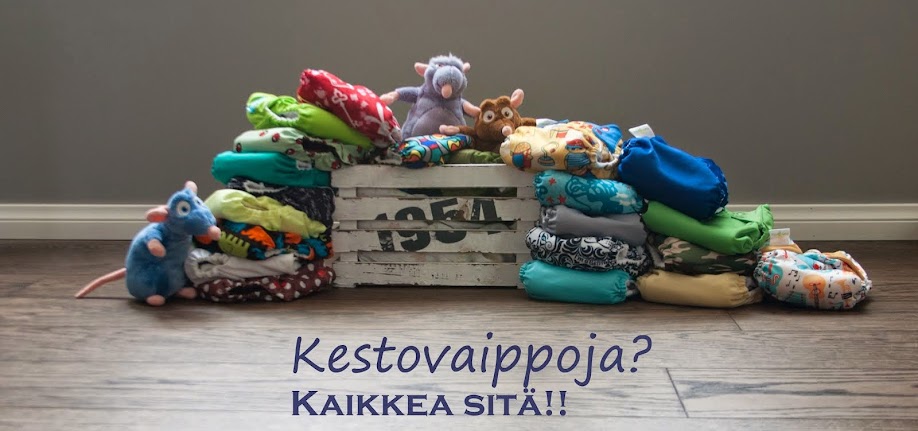Without the waterproof layer one couldn't manage cloth diapering. Or at least it would be a whole lot more difficult. To become water resistant the fabric needs to be treated. The most common process is Polyurethane Laminating, PUL.
Oletko koskaan miettinyt, mitä vaippojen PUL tarkoittaa? Kaikki kestovaippailevat äidit tietävät, että se on se vedenpitävä mutta hengittävä kerros, joka tekee nykyajan kestovaippailusta niin helppoa ja mukavaa. Mutta mitä se oikeasti on? Tämä on erittäin mielenkiintoinen aihe, sillä mitä enemmän tästä etsii tietoa sitä vähemmän sitä löytyy. Ja mitä enemmän tästä aiheesta lukee, sitä enemmän kaikki asiat ja termit menevät sekaisin. Itse kiinnostuin tästä, kun ostin vaipan, jonka PUL-kankaan valmistaja markkinoi olevan ympäristöystävällistä.
Have you ever stopped to think what PUL stands for? Every cloth diapering mom know it is the waterproof and breathing layer that makes today's cloth diapering so easy. But what does it all really mean? This is a very interesting subject. The more you try to find information the less you can find it. And the more you read about it the more you get confused. Personally I got curious about this when I bought a diaper that the manufacturer says having environmental PUL.
Tämän blogipostauksen kirjoittamisessa minua on auttanut ystävällinen mies toiselta puolelta maapalloa. GreenBeans Australia on perheomisteinen yritys, joka myy kaikkea kestovaippojen valmistamiseen tarvittavaa. Hamish Russilla oli aikaa vastata kysymyksiini PUL-teknologioista ja niiden ympäristönäkökohdasta. Kiitokset vielä kerran!
I got help writing this post from a friendly man from the other side of the Globe. GreenBeans Australia is a family owned business. They sell everything you need to make your own cloth diapers. Mr. Hamish Russ had the time to answer my questions about PUL technologies and their environmental aspects. Once again I thank you!
Hakusanalla "polyuretaanipinnoite" tulee linkkejä rakennusteollisuuden ja koneteollisuuden sivuille. Teknologiaa käytetään mm. ovien laminointiin, urheiluvälineisiin ja -varusteisiin sekä autoiverhoilutuotteisiin. Laajempi listaus TPU:n käyttökohteista löytyy American Chemistry Council.
When searching the web with "polyurethane lamination" you will get hits to sites of construction industry and machine industry. This technology is used for laminating door, sports gear and apparell, and for car interiors. A list of the usage of TPU is found here: American Chemistry Council.
Thermoplastic Polyurethane TPU on kankaalle levitettävä kalvo. Polyuretaanilaminointi on prosessi, missä TPU laminoidaan kankaalle. TPU kiinnittyy kankaaseen joko käyttämällä liuotinta tai PUR-teknologiaa.
Thermoplastic Polyurethane TPU is a sheet that is applied to the fabric. Polyurethane lamination is a process where TPU is laminated on to a fabric. TPU is bonded to the fabric by using a polyurethane based adhesive using either the solvent or PUR technology.
PUR is a process where glue chips are heated to liquify them and when cooling the PUL sticks to fabric. The bad side to this is that re-heating such PUL fabric over 60 degrees the lamination falls off. Is this the answer to why some cloth diapers break down in the dryer?
The owner of GreenBeans, Mr. Russ, says that the best method for laminating the fabric for diaper industry is by using solvents. This lamination process forms an unbreakable bond that stands the laundering for many years. GreenBeans is specialized in manufacturing PUL fabrics for the use of diaper industry and the priority of the company is to make high quality products. I got all excited at the GreenBeans web store! The fabrics seem top quality and they come in many beautiful colors. They also sell DIY kits for pocket diapers and there is a link to a pattern. The kit comes with a piece of PUL fabric and either microfleece or suedecloth of your own choosing, some Lastin and Hook & Loop. I thought that the price was alright: everything you need for approx 9 Euros. And then I realized the kit contains everything for three pocket diapers!
What about environmental values? Can either of the technologies be marketed as a greener choice? From an environmental aspect the end products is the same PUL fabric. Both technologies use chemicals but the PUL fabric manufactured with glue can break more easily and the product end up in the landfill sooner. The most environmental cover for diaper is wool pants.
Asiasta kiinnostuneet voivat etsiä lisätietoa hakusanoilla PUR ja TPU ja "solvent lamination".
Still interested? Try searching the web for PUR or TPU or "solvent lamination".

Ei kommentteja:
Lähetä kommentti